Mors Mo-clay Museum
- find the "gold" on The Island of Mors
Just to catch your attentionWe visit one of the best geological museums in Denmark. Here we find the turtle called "Luffe". It is unique, like gold to the creationist.
The name "Luffe" is the Danish name for the English "Flipper".
Read more about Luffe at the bottom of this article. But first you must know where Luffe was found. |
 |
|
We visit the Island of MorsWe go to the northern part of Jytland and find the Island of Mors in the fjord called "Limfjorden".
Here you see the cliff called "Hanklit" in Danish. It is 63 meters high. It was pushed up in the Ice Age and contains mo-clay and ashes from vulcanoes. |
 |
|
|
Here you see ashes from vulcanoes that erupted in the eocene era, when the continents drifted apart. See more information about this when you look at the article about the museum on the Island of Fur.
The paper in the middle of the picture is 15 cm long. The layer of ashes is thick. There are 179 layers of vulcanic ashes found in this area. |
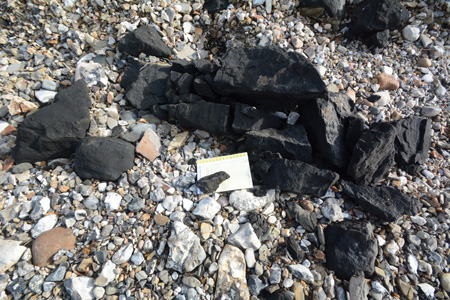 |
|
|
Here we are on the top of the cliff called Hanklit.
The ice glacier came from the north and pushed up this hill. It was not a powerfull buldozer!
In this area much mo-clay has been removed and used for heat proof briks for ovens. And cat litter.
Many fossils have been found i layers here in the northern part of The Island of Mors in Limfjorden. |
 |
|
|
Now we go inside the museum. It is a private museum that started in the beginning of the 1990's. |
 |
|
|
Well preserved fish has been found, often deeply embedded in sediments. |
 |
|
|
New fossils are currently being found. This fish was found by a German turist.
|
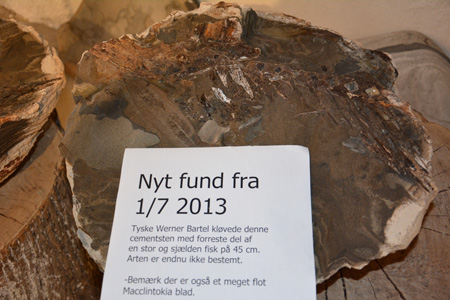 |
|
|
Besides fish also sea turtles are found. This one is called Luffe. It is so unique, that the museum sometimes must hand it over to the Danish state natural history museum i Copenhagen. In 2008 Luffe was deklared a national treasure. |
 |
|
|
Officially Luffe died 54 million years ago. The turtle is 11 cm long. It took 150 hours to uncover Luffe from the sediments.
More information at the end of this article.
See this video clip. > |
||
|
Birds are also found the mo-clayl. This bird is well proserved, even though the wings and breastbone is missing.
Notice that the bird must have been buried quickly. The fragile bones structure in the head must be covered quickly if the bird is being petrified.
A scientist from Germany sat examining this bird over a period of six weeks. You may use less time. |
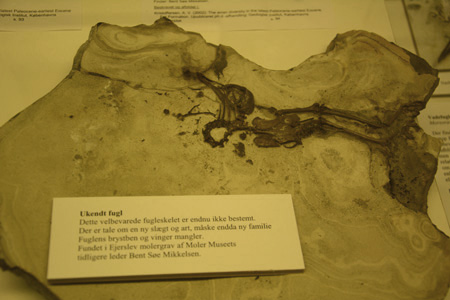 |
|
|
Here you see insect fossils. Look at the locust. So fantastic. All legs are intact. World class fossils.
The museum has record of thousand of insects found in the mo-clay. |
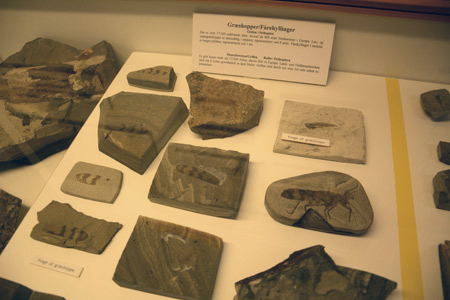 |
|
|
Here a piece of wook is placed between to layers of ashes from the vulcaones. Again a powerfull evidence for a rapid flood burial. There are no signs of decay. This is deposited in a period of days, not thousand of years.
The wood has the same color in the top and the bottom. Therefore it is buried quickly. |
 |
|
|
This is the biggest piece of petrified wood found i Denmark in december 1998. More than 6 meters long. Some parts of the wood were still biological tissue. Is was not possible to preserve the original tissue.
Real wood, biological tissue; it is only a few thousand years old. |
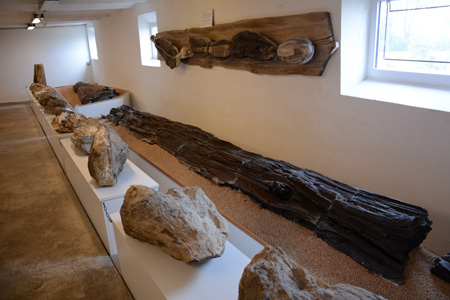 |
|
|
Again in 2014 more petrified wood was found. 4 meters long but in a lot of pieces.
|
|
Luffe the sea turtle at the Mors Mo-clay Museum
- finding the "gold" on The Island of Mors
Let us go into details with the little turtle.
Buried quickly and therefore well preserved even with some color pigments intact. Scientific reserch reveals that it has been buried within 6 days. Otherwise the head wouldn't be there.

"Luffe" is one of the best preserved turtles in the world
The State Natural History Museum in Copenhagen tells on their homepage:
This little turtle is a world class discovery. Never before has such a complete sea turtle been found. There are even remains of soft tissue. The special ting about this fossil is, that it is not onlyd the hard bones that are preserved. Even soft parts from the skin on the flippers and the horn edge og the shield. It is extremingly seldom to find this in fossils, because soft tissue will normally rot before the petrification starts to take over.
An American scientist has found a lot of sea turtles in North America. He performed some test on sea turtles and made some amazing discoveries. He wanted to find out how long it will take for the head and limbs to fall off a dead turtle.
After 6 days the head falls off. The limbs after 2-3 weeks. Therefore Luffe was buried quickly in the mo-clay sediments. It did not take hundred of years like the scientist in general will claim.
A Swedish scientist has recently found color pigments in the fossil. This is a rare discovery. You normally never hear about color pigments in fossils.
The color pigments in Luffe reveals, that it had the same colors as our sea turtles of modern time.
Luffe is shaking the geological time scale.